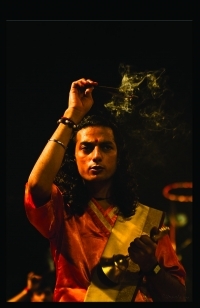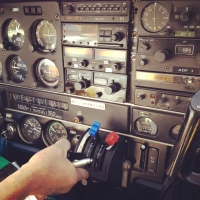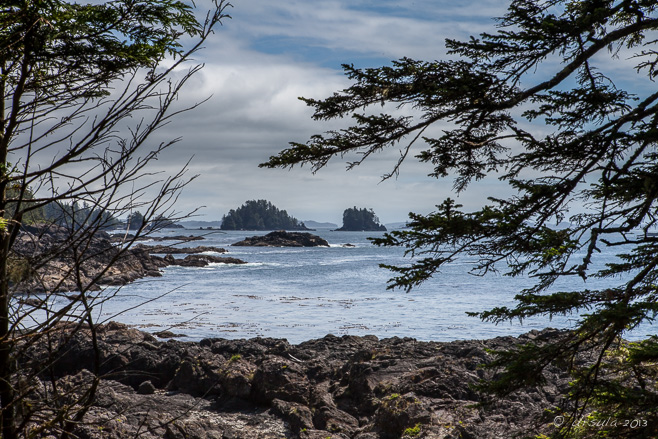 Through the Trees
A walk around the Wild Pacific Trail, Ucluelet provides great views over the rocky coast and wild water. The west coast of Vancouver Island is known for it’s wild storms.
“Storm watching” features strongly in all the tourism literature from the area – it might be one of the very few times a person could be less than happy about beautiful weather.
And we did have beautiful weather the day we stopped into the little district municipality of Ucluelet, BC, at the southern-most edge of the Pacific Rim National Park. We were on our way back to Nanaimo, along Highway 4, but had enough time for lunch and a short walk around the magnificent headland.
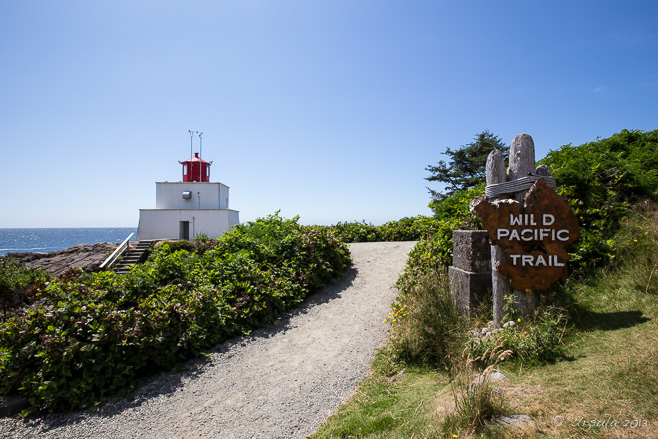 Amphitrite Point Lighthouse
An easy 2.6 kilometre walking loop starts and finishes near the light station, named after the British Royal Navy ship HMS Amphitrite, a Bombay-built gunship stationed in British Columbia in the 1850s. 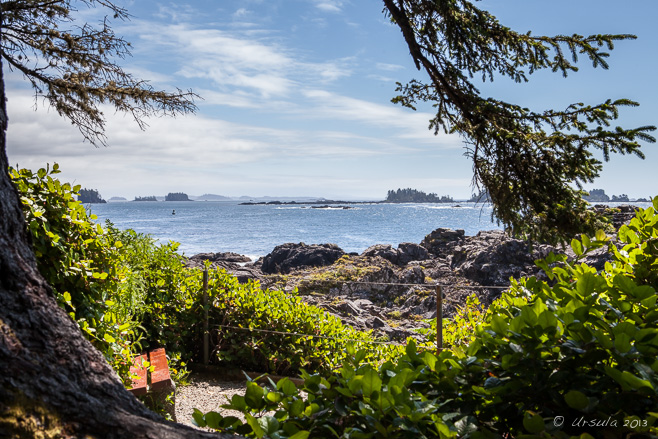 Looking West
The waters are tame today – but in winter, the coast can be pounded by thirty to fifty-foot waves, originating off the coast of Japan.  Memorial Bench
Benches are scattered all around the walking loop, so there is plenty of opportunity to watch the waves and wildlife. Whales are regular visitors, though we didn’t see any on our circuit.  Nature’s Artworks: Tree Stump
The walk is rich in texture and colour.  Twisted Trunks
Trees have responded to the wild winds and weather this coast is known for by twisting into fabulous shapes.  Horse Tails
The area gets an average of three metres (120 inches) of rain annually, making the forest undergrowth lush and green.  Moss and Ferns
The damp of the temperate rainforest is the perfect climate for rich mosses and ferns.  Forest Fruit
Delicate fruit and flowers provide colour contrast against the greens.  Squirrel
Although the pamphlet warns that walkers might come across bears, cougars or wolves, the biggest creature we spotted was this squirrel.  Old Plank Road
Hundred-year-old-remnants from the old elevated plank roadway that used to provide access to the lighthouse, are slowly sinking back into the land.  Old Stump  Western Red Cedar
Much of the Island’s forest cover is classed as “Mature”; that is, over 140 years old. Giant Pacific red cedar are everywhere.  Over the Waterways
The scenic views stretch in every direction.  Tiny Islands  Down to the Water
Bald eagles (none of which I caught on camera) soared overhead.  Spanish Moss  Amphitrite Point Lighthouse
Before we know it, we are back at the lighthouse and it is time to return to the car.  Black Bear
Once we were back on the road, we finally spotted an American black bear, ambling off, into the woods. 
It’s a short and easy hike along the well-maintained trail. The stunning ocean views and peaceful sections through ancient forests made it a worthwhile ramble.
And of course, the fresh ocean air helped pique our appetites for lunch in the local cafes before we headed back to the Island’s east coast.
Happy Rambles!
Pictures: 10July2013
 Girl at the Doorway
Proud and self-possessed, a young “untouchable” stands at the doorway of her simple home. There is something disturbing about having more valuable belongings in your travel bag than a whole village has within it’s boundaries.
This tension is inherent in travelling, particularly in photo-touring, in countries where wealth is poorly distributed. Although visiting under-developed areas – particularly with responsible operators – puts some much-needed cash into the local communities, it can still highlight huge disparities of income and opportunity.
This was brought home to me many years ago when I visited Fiji with my young children. They had saved up their birthday- and pocket-money, and had bought themselves new electronic games at duty-free while we were in transit. When we visited a remote Fijian village, accessible only by boat, I watched the children there playing in a dirt patch with coconut half-shells as their only toys. We had more “goods” in our holiday bungalow than these children had in their homes.
I recalled this experience when I was in the Thar Desert in Rajasthan last November. I was staying in the rather luxurious Manvar Desert Camp & Resort, Dechu, with photographer Karl Grobl, Rajasthani guide DV, and a small group of photo-enthusiasts. As it turned out, our tented accommodation, complete with electric heating, flushing toilets, and hot-and-cold water, stood in rather stark contrast to the local villages nearby.
 Manvar Desert Camp
As we bump over dusty, desert roads, the tented resort where we will be staying comes into view.  Tents in the Desert
Set amid desert shrubs and grasses …  Manvar Desert Tent
… the tents are airy, roomy, and comfortable.  Wooden Camel
It is the little touches that make a room a “home”.  Jeeps in the Desert
After settling into our tents, we head out across the bumpy dirt tracks again…  Desert Village
… stopping at a local village in the middle of the desert to visit.  Kids at the Fence
The village children collect at the gates of the houses to have a look at the visitors.  Village Kids
After working up their nerve, the boys come out to stare.  Long Walk
Other people pay us no mind as they go about their daily business.  Young Girl in her Finery  Looking after Baby
A young girl looks after a toddler, who is marked as a Hindu by the tika on the forehead, and protected against being cursed by kohl around the eyes.  Old Man in the Courtyard
In the well-swept courtyard of one of the homes, more young children gather around an elderly man.  Village Elder
His regal bearing belies his “untouchable” background.  On the Wall
Pots and utensils nestle into outdoor shelving.  Tilling Sand?
It is hard to believe that anything is going to grow in the neatly tilled rows of sand.  Kids and Carers
There is no shortage of children in the village.  Woman in her Courtyard
Bangles and other jewellery items are a local wealth-indicator.  Family
A woman poses with two of her children – almost a generation apart.  Getting Water
Clay jars of water sit in the courtyards for anyone who wants some.  Every Village Needs a Cow  Keeper of the Keys  Another Baby  The Village Well  Bringing Home the Goats
As the afternoon draws on, the young boys race home with the goats…  Bringing Home the Goats
… and the girls, with their young charges, watch.  Into the Sunset
We pile back into our jeeps, and drive into the lowering sun …  Desert Sunset
… arriving back at camp in time to watch the red sun set into the desert shrubbery.  Night Tents
Our tents are lit and waiting. I do think it is hugely important to travel with responsible operators who help local communities develop according to their own priorities.

And, it is necessary to visit with open eyes and respect.
But, there is still that tension.
‘Till next time, Namaste.
09November2013
Posted in Every Day Life,India,Portraits,RuralTags: animals,architecture,blog,children,environmental portrait,environmental portraits,nature,people,Photo Blog,portrait,portraits,travel,Travel Blog,Ursula Wall
 Sandra and Her Baby
A rehabilitated semi-wild orangutan (Pongo abelii) visits the feeding station in Gunung Leuser National Park with her young baby. Never have I felt more like David Attenborough.
You know: in that classic, ground-breaking twelfth episode of Life on Earth (1979), investigating primates and their “Life in the Trees”, where the broadcaster and naturalist finds himself face to face with an adult female mountain gorilla in Rwanda, and turns to talk softly to the cameras.
We were in Asia, not Africa, and they were orangutans, not gorillas, but as I crouched in a jungle clearing, talking softly while a wild primate walked not four feet away from me, I felt that sense of awe and momentary connection. There is something magic about making eye-contact with a sentient ‘forest person’ (orang utan in Malay) in her own environment.
We had been in the jungles of Gunung Leuser National Park in North Sumatra for over three hours, much of it trekking across steep, slippery and narrow trails before our “wild” encounters, and we were having a wonderful morning.
Join me on a rare opportunity to visit a small portion of the UNESCO World Heritage site 1167: ‘The Tropical Rainforest Heritage of Sumatra’.
 Sun on the Bahorok River
Just two weeks before our stay at Bukit Lawang, volcanic Mount Sinabung, about 50 km south as the crow flies, erupted, killing at least 14 people. The volcanic ash still hung thick in the air, like smoke.  Bridge to Bukit Lawang
From our “Ecolodge”, we crossed …  Bathing Huts on the Shore
… over the Bahorok River, where the locals were picnicking and bathing, …  Rusty Roofs
… into the small tourist village of Bukit Lawang.  Bukit Lawang Locals
Local Indonesians watch our progress through the muddy ‘main street’.  Dinghy-Ferry
Access to the Gunung Leuser National Park is by inflatable dinghy.  Happy Boatman
The boatman who steered us across the river thought we were pretty entertaining.  Sepi and the Ranger
The first orang-utan to visit the feeding station, located a short walk into the park, was seventeen-year-old Sepi.  Sepi and her Baby
Her two-and-a-half-year-old baby never left her side.  Park Ranger
At the Bukit Lawang Rehabilitation Centre, orangutans who had been rescued from captivity were taught the skills necessary to survive in the wild, and released into Gunung Leuser National Park. More than 200 orangutans have been released, and the rangers monitor their progress. The daily feedings at the platform help the orangutans supplement their diets until they can be fully independent. It also allows visitors a view of the semi-wild primates.  Sandra and Her Baby
The second orangutan to visit the feeding platform was 40-year-old Sandra with her fourth, and presumably last, baby. Female orangutans have eight-year intervals between babies; for the first four months, infants cling to their mothers, and they are completely dependent for two years.  Long-Tailed Macaque
Clearly not the alpha-male, this macaque (Macaca fascicularis) had been in the wars and lost: his facial and leg injuries looked recent. He kept a careful watch as he picked over the scraps left on the feeding platform.  Through the Jungle
Our guide asked us if we were feeling ‘strong’, and then led us into the jungle on the not-so-easy path…  Lost?
… up hills so steep we were clinging to vines and roots, and through foliage so thick we often lost sight our guides.  Thomas Leaf Monkey
Our sharp-eyed guides found some delightful blue-grey and white Thomas’s Langurs (Presbytis thomasi).  Thomas Leaf Monkey
Endemic to Sumatra, this vulnerable monkey – like the orangutan – is threatened by habitat loss.  Thomas Leaf Monkey
As long as the guides had bananas, the monkeys were happy to visit us.  Thomas Leaf Monkey
With their mohawks and whiskers, they are very cute.  Official Park Guide
Ayub, one of our guides, was adept at spotting and calling animals. The use of official guides is important for the care and protection of the animals – and for the livelihood of the local community.  Swinging In
Orangutans, especially the Sumatran ones, spend nearly all their time in the trees. Ratna swung in to see what our guides had to offer when she heard Ayub calling her.  Ratna
She dropped to the ground, and it was wonderful to be so close to her as she walked past me to retrieve a carrot.  Juvenile
Ratna’s youngster, a gorgeous little fluff-ball, stayed safely up in the trees.  Ratna and her Juvenile
Juveniles are usually weaned at about four years of age – so this one won’t be nursing much longer.  Orangutan
The guides had no name for the last orangutan we met because she was born in the wild. During his encounter with the gorillas, (Sir) David Attenborough said: “There is more meaning and mutual understanding in exchanging a glance with a gorilla than with any other animal I know.”
Looking into the gentle brown eyes of the critically endangered Sumatran orangutans, the same could be said.
As soon as we walked out of the park boundaries, we were back in the rubber plantations, much like those we’d seen, mile after mile, on the drive from Medan the day before.
 Young Rubber Plantation
Rubber trees stretch into the distance, making it easy to see how challenging it is to protect the remaining small patches of wild habitat. 
The less-than-7000 remaining Sumatran orangutans inhabit only a tiny corner of the planet –
We need to help them keep it.
Pictures: 16February2014
Posted in Adventure,Animals,Indonesia,NatureTags: animals,blog,environmental portrait,Gunung Leuser National Park,National Park,nature,Photo Blog,portrait,travel,Travel Blog,UNESCO,Ursula Wall
 Like a Dance
A stunning sunset on Inle Lake throws a leg-rowing fisherman into bold silhouette. There are some scenes so iconic that they could take place nowhere else.
So it is with the leg-rowing fishermen of Inle Lake in the Shan Hills of Myanmar. They are so uniquely Burmese that images of these men – standing on the sterns of their boats with one leg wrapped around an oar – often feature in travel advertising and features.
Inle Lake, Myanmar’s second-largest body of water, is in the heart of the Shan State, and home to about 70,000 Intha (“sons of the lake”) people. Four large cities and numerous small villages border the lake, but many Intha live on the lake itself, in houses built high on stilts rising out of the lake waters. Reeds and other floating plants also rise high out of the waters, so that when you are sitting low in a boat, it can hard to see and to steer a clear route through the vegetation. It is for this reason that, while the local women still row their boats in the usual manner, the local fishermen developed their distinctive standing rowing style.
I was very excited to have the chance to see these fishermen in action for myself, thanks to photography tour-leader Karl Grobl and local guide Mr MM.
Watching a fisherman demonstrate how he lowered and raised the huge, woven fish trap, and watching him row and balance on his boat, I was mesmerised. His movements were slow and hypnotic; the boat glided almost silently. It was like watching a beautiful dance.
The superb sunset we were treated to was an unexpected bonus.
 Leg Rowing Fishermen
The local Intha people take their livelihoods from Inle Lake.  Readying the Net
Some fishermen use nets rather than the traditional fish-traps. The wooden boats sit so low in the water, they look submerged.  Balancing the Net
It is hypnotic watching the fisherman manoeuvre …  Balancing the Net
… balancing his boat, his oar and his oversize fish-trap.  Stepping down the Fish Trap
Fishing on Inle Lake is a physically strenuous activity. Traps are pushed into the water by foot, …  Retrieving the Fish Trap
… then pulled out again – hopefully with fish. There are nine endemic species of fish in the lake, as well as more common varieties.  Intha Fisherman  Portrait of an Intha Fisherman  Intha Fisherman
The Shan Hills rise up in the background as the dance continues.  All Smiles
I think our fisherman is enjoying this!  Delicate Balance
When he’s not rowing with his foot, …  Delicate Balance
… our Intha fisherman is using it to stabilise his net.  Portrait of an Intha Fisherman  Sunset Skies
As the afternoon stretches into evening, the clouds roll in and the sun angles lower.  Golden Light
… setting fire to the waters.  Leg Rower in Golden Light  Changing Light
Minute by minute, the skies change behind our fisherman on Inle Lake.  Fisherman in Purple  The Dance Continues
The sunset skies outline our fisherman against fabulous colour.  Fire and Ink
Soon it will be too dark to see…  Dark Skies
… leaving only the silhouette of the man and net against the dark skies. It was a magnificent display – by both man and nature.

Leaving the scene, my travel companions and I were quiet – awed by the spectacle we had witnessed.
Truly, it was an iconic scene: a leg-rowing fisherman against an unbelievable sky.
It could be nowhere but Inle Lake – Myanmar.
Pictures: 20September2012
Posted in Myanmar,Travel,WorkTags: blog,boats,environmental portrait,fishing boats,iconic,people,Photo Blog,portrait,travel,Travel Blog,Ursula Wall,work
 Polisi
Indonesian policemen on clean-up duty at Maimoon Palace, Medan, North Sumatra, take the opportunity to photograph me. It is only a short hop from Singapore to Indonesia by boat or plane, but it may as well be a whole world away (q.v. From Resort to Reality).
Last month, after a week in the ultra-modern high-rise city-state of Singapore (Magical Flying Machines and Gardens by the Bay), my husband and I took a side-trip to Sumatra, Indonesia’s largest island. The flight from Singapore’s Changi Airport to Medan takes just over an hour. As soon as we walked out of the brand-new Kualanamu International Airport, however, there was no doubt that we had arrived in a different country: old Dutch colonial buildings rubbed shoulders with Moghul architecture; decrepit vehicles crowded the dirty, littered streets; political posters and billboards competed for attention; and the heat, dust and smells tried to work their way into our vehicle. According to Lonely Planet, Medan regularly comes up in response to: ‘What’s the worst place you’ve ever visited?’
But for all this, after the high-octane buzz of the somewhat-sterile Singapore, I found North Sumatra markedly more relaxed. Instead of rushing around, staring at or talking into their phones, people actually looked at us – and smiled. They took the time to chat and have their pictures taken. Except for the chaotic traffic, everything was slower.
It is, indeed, a very different place.
 “Selamat Bahagia”
Colourful billboards sponsored by local businesses offer their “Congratulations” to selected newlyweds in Medan.  Maimoon Palace
Tourists on the red carpet outside Maimoon Palace, Medan.  Shoes on the Marble
Nothing says “Asia” more clearly than a pile of shoes outside a public building.  Podium of the Sultan
Maimoon Palace was built in 1888 by Sultan Ma’mun Al Rasyid Perkasa Alamsyah, who ruled Medan from 1873 to 1924 – thanks to his good relations with the Dutch who were expanding their tobacco trade in the area.  Outer Pavilion
There is half a cannon housed inside the pavilion that sits in the palace grounds. The story is that the very beautiful Princess of Deli Tua rejected a marriage proposal from the King of Aceh to the north. The King was so angry he invaded and was about to win the war, until one of the princess’ brothers turned himself into a cannon, shooting out wildly, and preventing the King’s troops from capturing her.  Children in Traditional Dress
There is a wardrobe booth inside Maimoon Palace, and you can dress up as a Dato’ (Sultan) or a Princess, and then have your picture taken inside the buildings. Costumed by their parents, these children posed happily for me as well.  Interior
The palace architecture is a mixture of cultures and styles. The predominant colour is yellow, a Malay favourite, and the design blends European, Islam, Spanish, Indian, and Italian elements.  Police Clean-Up
Maimoon Palace is still used for special events. The local police are enlisted as security and clean-up detail.  Police Crew
Seeing me with my cameras, the clean-up crew spontaneously came together for a group photo.  Dutch Influence
Dutch colonialists were significant in developing the area from the 1860s, and the buildings in Medan reflect this.  Tjong A Fie Mansion
Completed in 1900, the Chinese-European, art-deco style mansion built by Tjong A Fie (1860-1921), a prominent Hakka merchant who owned much of the land around Medan, is a distinctive contrast to the other buildings around it.  Field Post Office
The post office in the middle of Medan, completed in 1911, is another example of Dutch colonial architecture.  Becak 3-Wheeled Taxi Cab
In the square outside the post office, becak drivers wait for customers…  Parking Warden
… while officers monitor the parking in the area.  Australian Troops
Tip Top Restaurant (and its menu) traces back to Dutch colonisation. As I drank my locally-grown coffee in what was once, reputedly, “THE restaurant in Medan”, I was taken by the historic photograph of Allied troops marching through the Medan streets in 1947.  Open-Plan Kitchen
Well west of Medan, we stop for lunch, which is cooked in a hot, dark kitchen, over open flames.  Turangie Palm Plantation
Since 2009, Indonesia has been the world’s largest producer of palm oil, giving the country’s economy a much-needed boost, but contributing to social and environmental problems…  Oil Palm
… including de-forestation, soil and habitat degradation …  Turangie Palm Oil Mill
… and polluting smoke from the processing plants.  Rubber Trees
Of course, rubber plantations are just as damaging to the soil. Indonesia is the world’s second largest natural rubber exporter.  Girl in Purple
In the rubber plantations, we met a young girl, whose father is British …  Mother and Son
… and her best friend, whose father is German. The friend’s mother described her work tapping the rubber trees.  Bridge to the Eco Lodge
At Bukit Lawang, a suspension bridge leads us over the Bahorok River to our accommodation.  Perhaps it is fitting that, in this “other world”, we had a dip-bucket rather than a shower, and we had no hot water in our open-air bathroom… Perhaps it is fitting that, in this “other world”, we had a dip-bucket rather than a shower, and we had no hot water in our open-air bathroom…
Never mind! We had a national park next door: home to the few remaining Sumatran orangutans, whom we planned to visit the next day – showered or not!
Till then, Keep Smiling!
Pictures: 15February2014
Posted in Architecture,Indonesia,Landscapes,Portraits,TravelTags: architecture,blog,environmental portrait,environmental portraits,Indonesia,people,Photo Blog,portrait,portraits,rural,travel,Travel Blog,Ursula Wall
« Older posts
Newer posts »
|






















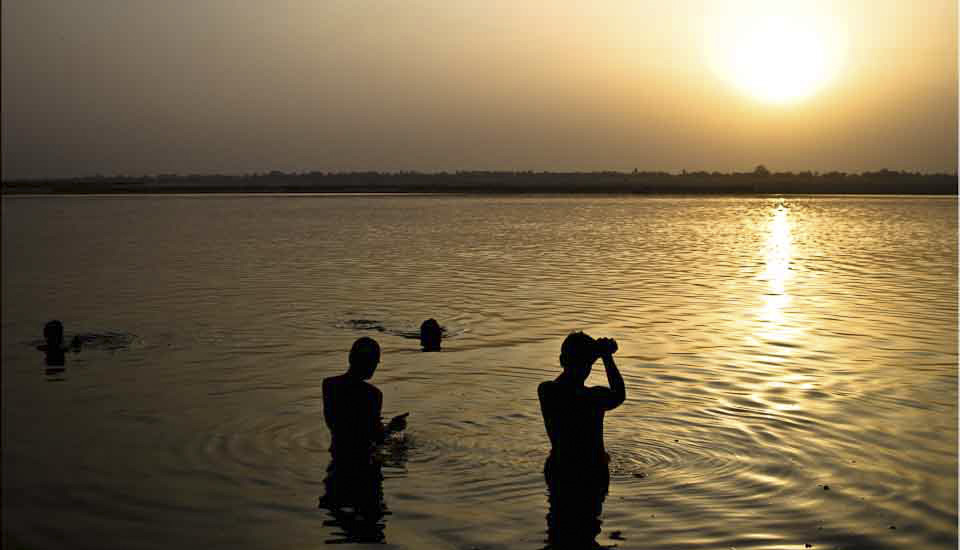


































































































 Perhaps it is fitting that, in this “other world”, we had a dip-bucket rather than a shower, and we had no hot water in our open-air bathroom…
Perhaps it is fitting that, in this “other world”, we had a dip-bucket rather than a shower, and we had no hot water in our open-air bathroom…























.jpg)
